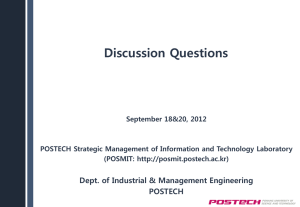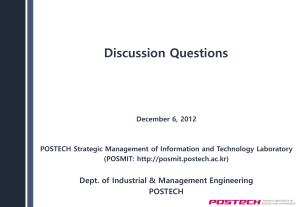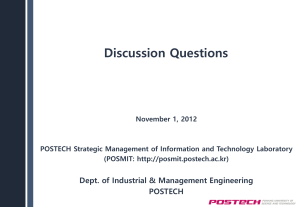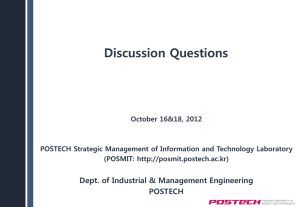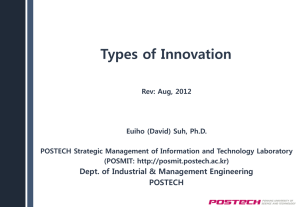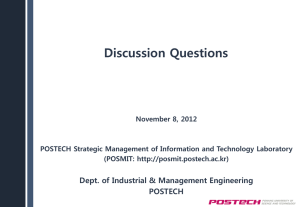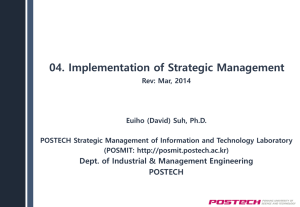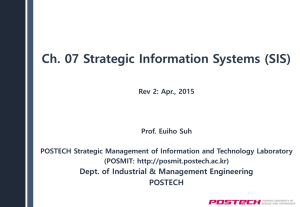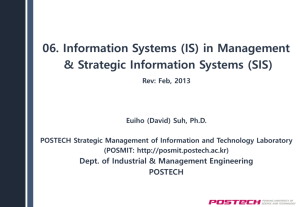05.Basic_Concepts_of_IS
advertisement
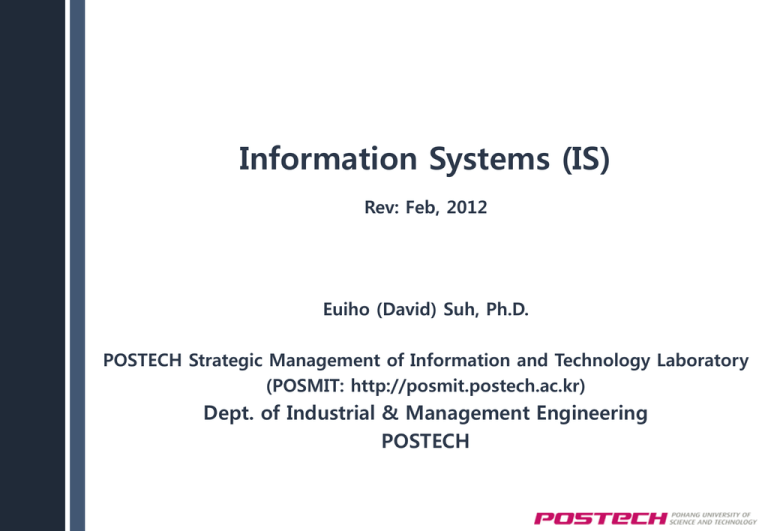
Information Systems (IS) Rev: Feb, 2012 Euiho (David) Suh, Ph.D. POSTECH Strategic Management of Information and Technology Laboratory (POSMIT: http://posmit.postech.ac.kr) Dept. of Industrial & Management Engineering POSTECH Contents ※ Discussion Questions 1 Information Systems 2 3 1) Introduction 2) Components of IS 3) General role of IS Information Systems in Management 1) Problem types 2) The relationship between IS and Management 3) The role of IS in Management Case Study Discussion Questions (1/2) ■ Explain the difference between data and information. ■ In a larger extent, what is the difference among data, information, decision aids, and knowledge ? (Refer to No. 6 PPT) ■ Refer to THREE key attributes of information. Are the attributes of information mutually independent ? ■ What is the least important component of IS among 6 components? ■ What is the ultimate purpose of information systems ? ■ DSS more focuses on solving (structured, semi-structured, unstructured) problem than (structured, semi-structured, unstructured). Justify your answer. ■ Take an example of a semi-structured model and suggest how to solve it using an IS. ■ By using IS, what were benefits E-mart gained? 3 Discussion Questions (2/2) ■ Case 1 in textbook (pp. 5~6, Chapter 1) – How do information technologies contribute to the business success of the companies depicted in the case? • Provide an example from each company, explaining how the technology implemented led to improved performance – The Bryan Cave law firm used BI technology to improve the availability, access, and presentation of existing information; this allowed them to provide tailored, innovative services to customers • What other professions could benefit from a similar use of these technologies, and how? ■ Discussion questions in textbook (p. 39, Chapter 1) – Refer to the Real Word Case on eCourier, Cablecom, and Bryan Cave in the chapter. Jay Bregman, CTO and cofounder of eCourier, notes the company hopes their innovative use of technology will become a differentiator in their competitive market. More generally, to what extent do specific technologies help companies gain an edge over their competitors? How easy or difficult would be to imitate such advantages? – Why do big companies still fail in their use of information technology? What should they be doing differently? 4 1. Information Systems What is Information? 1) Introduction ■ Definition of Data – Raw facts, typically about physical phenomena or business transactions • Specifically, objective measurements of the attributes of entities such as number, name, etc. ■ Definition of Information Facts that are organized and arranged in a meaningful manner. ■ Data vs. Information (statistical analysis) Data The transformation process ■ Attributes of information – – – – – – – – – Accuracy Timeliness Relevance Completeness Reliability Simplicity Verifiability Flexibility Economy 5 Information 1. Information Systems What is a System? 1) Introduction ■ Definition of System – A set of interrelated components, with a clearly defined boundary, working together to achieve a common set of objectives by accepting inputs and producing outputs in an organized transformation process Processing Input • Capturing and • Transformation Output • Transferring assembling process transformed elements that converts input elements to enter the into output their ultimate system to be destination processed 6 1. Information Systems What is an Information System? 1) Introduction ■ Definition of Information System – A set of interrelated components which are to collect, process, store, and distribute information to support decision making and control in an organization Information System 7 1. Information Systems What Does an Information System Do? 1) Introduction ■ An information system performs three general activities – It accepts data from sources as input – It acts on data to process(produce) information : information generating system – The system outputs the information for the user, manager or staff member ■ Information System Process Input of data Information generating Output First Step Second Step Third Step 8 Components of Information System (1/3) 1. Information Systems 2) Components of IS ■ Does an Information System Need Computer? 95% 5% Yes No As the volume of work grows procedures increase in complexity, activities become more interrelated, improvements can be gained by introducing computer assistance 9 Small size management Components of Information System (2/3) 1. Information Systems 2) Components of IS A set of people, data, procedure to provide useful information People Communication of information Information System Data Management of activities Decision making Procedure 10 / 13 10 Components of Information System (3/3) 1. Information Systems 2) Components of IS ■ E.g. Components of a Loan Information System • Fund on deposit • Loan balance • Balance financial plan • Loan portfolio Banking database Processor Computer based loan information systems Information supplied by applicant for loan • Financial status • Loan details • Employment status Economic database • Employment data • Economic data 11 Why do we study Information Systems?(1/2) Collect, distribute, analyze Data Why? Get information Why? Remove uncertainty Why? Make a good decision Why? Store knowledge 12 1. Information Systems 3) General role of IS Why do we study Information Systems?(2/2) Vital component of successful businesses Improves efficiency and effectiveness of business processes Strengthens competitive position in rapidly changing marketplaces Facilitates managerial decision making & workgroup collaboration 13 1. Information Systems 3) General role of IS Benefits and Uses of Information Systems 1. Information Systems 3) General role of IS Product • • Added Value to Products (Goods & Services) Higher-quality Products Labor • • Improved health care & communications Reduced labor requirements & costs Management Quality • Increased efficiency & productivity • Superior financial decision making, control over, operations, and managerial decision making • Fewer errors • Greater accuracy • Better Safety & Service 14 2. Information Systems in Management Problem Types Structured Problem Unstructured Problem Semi-structured Problem 1) Problem types Input Problem Structure Definite Output Input Problem Structure Fuzzy Output Input Problem Structure User dependent Output User Interaction User 15 What types of Information Systems Exist? 2. Information Systems in Management 2) The relationship between IS and Management IS Recognition about Information The advent TPS(Transaction Processing System) Efficiency Computer To process data about transactions MIS(Management Information System) Control Database To enable people to make decision(action) DSS(Decision Support System) Decision PC and Model based ESS(Executive Support System) Strategic Resource Executive Support ES(Expert System) Knowledge AI To mimic the decision process of a human expert ERP(Enterprise Resources Planning) Management IT To integrate management information across an entire organization Work Group Support System Communication Communication 16 Explanation To assist managers with unique strategic decisions that relatively unstructured To assist top-level executive To exchange information (ex: EDI, WP) 2. Information Systems in Management Evolution of IS 1950 2) The relationship between IS and Management 1960 1970 1980 1990 2000~ TPS(Transaction Processing System) MIS(Management Information System) DSS(Decision Support System) ESS(Executive Support System) ES(Expert System) ERP(Enterprise Resources Planning) WGSS(Work Group Support System) 17 A Business Perspective on Information Systems Organizations 2. Information Systems in Management 3) The role of IS in Management Technology Information Systems Management 18 Technical & Behavioral Approaches to MIS 2. Information Systems in Management 3) The role of IS in Management Technical Approaches Operations Research Computer Science Management Science Sociology MIS Political Science Psychology 19 Behavioral Approaches Case Study ■ Domestic Case Click Here 20 Reference ■ O’Brien & Marakas, “Introduction to Information Systems – Fifteenth Edition”, McGraw – Hill, Chapter 1, pp. 3~42 ■ Euiho Suh, “Introduction to Information Systems (PPT Slide)”, POSMIT Lab. (POSTECH Strategic Management of Information and Technology Laboratory) ■ Euiho Suh, “Information & Management (PPT Slide)”, POSMIT Lab. (POSTECH Strategic Management of Information and Technology Laboratory) 21
